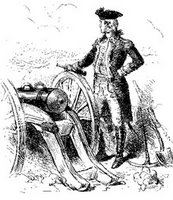Gen. George Washington chose that mansion as his home and workspace from the middle of July 1775 to the start of April 1776. One of the biggest management challenges he had to tackle in those months was remaking the American artillery.
The Battle of Bunker Hill threw the regiment into chaos, with Col. Richard Gridley wounded and the other officers overwhelmed by the demand for fortifications and grousing at each other. Making changes was politically thorny, but Washington saw no way to win the siege without good military engineering and heavy artillery.
By the end of 1775, Washington had engineered the appointment of Knox as colonel, kicking Gridley upstairs to be the army’s Chief Engineer. Washington had also launched two initiatives that brought more heavy ordnance to the siege lines, making the March 1776 push onto the Dorchester peninsula worthwhile. My talk “Washington’s Artillery: Remaking the Regiment Between Bunker Hill & Dorchester Heights” will explore those developments and look at these questions:
- How did American artillerists perform in the Battle of Bunker Hill?
- What did Gen. Washington expect to find when he arrived at Boston?
- Why was it so hard to appoint majors in the artillery regiment?
- What are the myths and realities of Knox’s trek from Lake Champlain?

What are the myths and realities of Knox’s trek from Lake Champlain? - that is an amazing subject worthy of its own talk...
ReplyDeleteWhat always amazed me in my limited study of it -
The young age of Knox given the responsibility and money involved.
The differences between New York and New England in the use of horses/oxen.
The weather needs - building sleds with no snow, need Lake George free of ice to get down it then snow/ice for the sleds and to cross the Hudson.